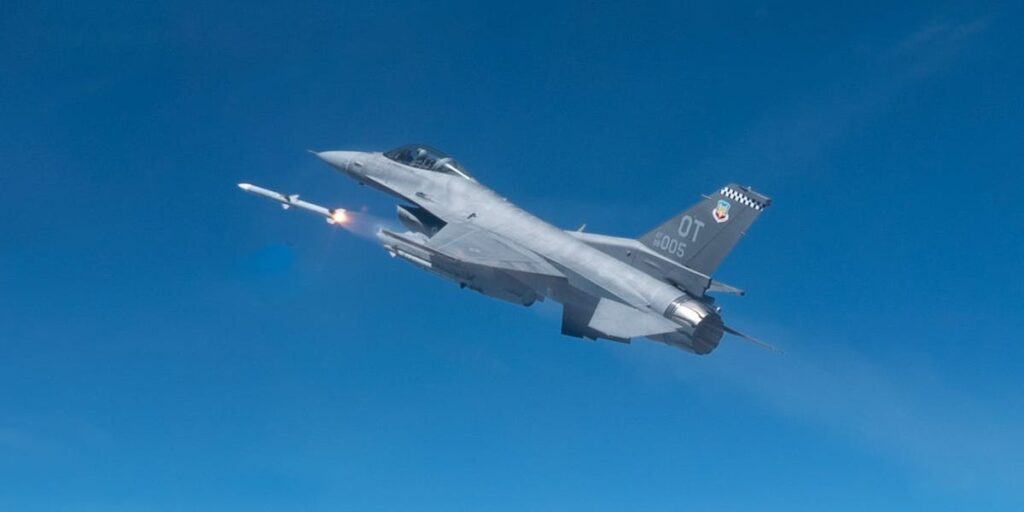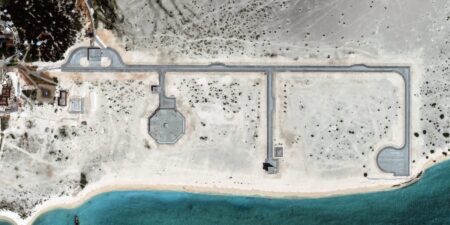The US is sending Ukraine air-to-air missiles to go with the new F-16 fighter jets coming this summer from European partners, per a new report on armaments.
Ukraine will receive the AIM-120 Advanced Medium-Range Air-to-Air Missile, known as the AMRAAM, and the AIM-9X missile, The Wall Street Journal reported Tuesday. The US also plans to send Kyiv more air-to-ground munitions.
The F-16 Fighting Falcon is a capable fourth-generation aircraft expected to provide a capability boost, augmenting Ukraine’s current fleet of aging Soviet fighter jets, but its effectiveness will, in part, be determined by the weapons with which it flies.
Top US generals and Ukrainian officials have cautioned that the fifty-year-old F-16, while an effective combat platform able to perform offensive and defensive operations, won’t be a game changer. It faces a daunting operating environment in Ukraine and will likely be a top target for Russia’s air-defense systems. Kyiv also simply is not getting enough of the aircraft. That said, there’s a lot it can do.
Powerful air-to-air missiles
The AIM-120 is an all-weather, beyond-visual-range air-to-air missile with active radar for decreased dependence on the aircraft for intercepts. It was built as a follow to the AIM-7 Sparrow missile that Ukraine already has in its arsenal for air-defense purposes.
It’s unclear exactly which AIM-120 variants Kyiv is receiving or how many. Earlier models of the missile have a range of over 20 miles, while the newest one — the AIM-120D — is said to reach beyond 100 miles. The earliest AIM-120 design was fielded in the early 1990s.
A Ukrainian Air Force official said last year that the US would offer the country with AIM-120 missiles that can travel more than 100 miles, pointing to one of the newer variants. Some airpower experts, however, have expressed skepticism that Kyiv would actually get newer weapons because the technology may be too sensitive for the US to risk losing.
On the other missile Ukraine is receiving, the AIM-9X is a short-range air-to-air missile with an infrared seeker and is the newest variant in the Sidewinder family. Like the AIM-120, its specific range is classified. Ukraine already owns the AIM-9M, which has a range of up to 18 miles. The earliest Sidewinder versions entered service in the mid-1950s. Though the AIM-9 is an older system, it’s considered to be highly successful.
Armed with AIM-120 and AIM-9X missiles, the F-16 could be used for air-to-air combat against other fighter aircraft, though that may not be the best use. The Russians are operating Su-35 and MiG-31 fighter jets that carry long-range air-to-air missiles like the R-37. These capabilities would seriously threaten an F-16. Greater reach could be decisive, but there are other factors in play in air-to-air combat.
As an alternative, Kyiv can use its F-16s to engage Russian cruise missiles, one-way attack drones, and, potentially, the fighter-bombers that are releasing the highly destructive glide bombs that are pounding Ukraine.
Col. Gen. Oleksandr Syrskyi, Ukraine’s top general, told the Guardian earlier this month that the arrival of the F-16s would strengthen his country’s air defenses, but he acknowledged that the jets would likely need to stay at least 40 kilometers or more from the front to avoid being shot down.
Experts at the Center for Strategic and International Studies think tank wrote last month that “once introduced on the battlefield, F-16s will increase the Ukrainian Air Force’s air-to-air capabilities.”
With its powerful radar and AIM-120 missiles, the F-16 will provide “an appreciable engagement range improvement compared to Ukraine’s Soviet-era MiG-29 and Su-27 fighter aircraft,” they argued.
Using its F-16s in a defensive role would help Ukraine relieve some pressure on its existing air defense apparatus, which has been hamstrung by a limited supply of interceptor missiles and available batteries. These include both Western systems like US-made Patriot batteries and NASAMS and Soviet-era equipment.
Beyond air-to-air engagements, Ukraine can use its F-16s in an air-to-ground role, executing suppression and destruction of enemy air defense missions.
Kyiv already has US-provided AGM-88 HARM missiles — or high-speed anti-radiation missiles — to hunt down enemy radar systems, and more are coming with the new jets. With F-16s, Ukraine can potentially better use these weapons to degrade Russia’s vaunted air-defense capabilities. The Ukrainians previously jury-rigged them onto its Soviet aircraft.
A coalition of several NATO countries — Denmark, Norway, Belgium, and the Netherlands — have promised Ukraine some 80 F-16s, although the deliveries will be spread out over time. Ukrainian President Volodymyr Zelenskyy said earlier this month that Kyiv will need more than a few dozen of the aircraft to actually make a difference. He also suggested they were needed earlier.
Gen. James Hecker, commander of NATO’s air command, said Tuesday that the F-16s won’t be a “golden bullet” for Ukraine that will immediately win them air superiority because they’re going up against advanced Russian air-defense systems.
Hecker said at an event hosted by the Mitchell Institute for Aerospace Studies that the American-made aircraft will help bring Ukraine even closer to the West and help shift its forces to be more aligned with NATO tactics, procedures, and equipment.
“It does move them a step in the right direction,” he said.
Read the full article here















